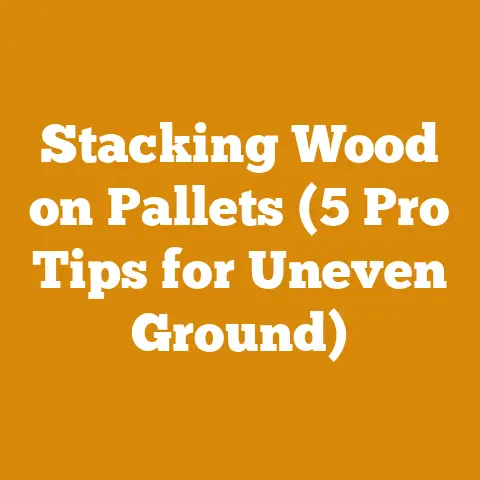Stage 3 Creosote Remover Tips (5 Pro Tricks for Safer Burning)
Stage 3 Creosote Remover Tips (5 Pro Tricks for Safer Burning)
Introduction: Breathe Easier, Burn Safer: Why Creosote Removal Matters
There’s nothing quite like the warmth and ambiance of a wood-burning stove or fireplace on a chilly evening. But behind that cozy flame lurks a potential danger: creosote. As a seasoned wood processor and firewood enthusiast, I’ve witnessed firsthand the devastating effects of unchecked creosote buildup. Beyond the immediate fire hazard, excessive creosote can impact your respiratory health and the overall air quality in your home. We will explore five proven techniques for tackling Stage 3 creosote, ensuring safer and more efficient burning, and ultimately, a healthier home environment.
Understanding the Creosote Threat: A Wood Burner’s Primer
Before diving into the removal strategies, it’s crucial to understand what creosote is, how it forms, and why it’s so dangerous. Creosote is a tar-like substance that’s a byproduct of incomplete combustion when burning wood. It’s composed of unburned wood particles, gases, and moisture that condense inside your chimney flue.
The Three Stages of Creosote Buildup
Creosote doesn’t just appear overnight. It progresses through three distinct stages, each presenting its own level of risk and requiring different removal approaches:
- Stage 1: This is the initial stage, characterized by a light, flaky soot that’s relatively easy to remove. Think of it as the powdery residue you might find in your fireplace after a few burns.
- Stage 2: As burning continues without proper cleaning, the soot hardens and becomes more tar-like. This stage requires more aggressive cleaning methods.
- Stage 3: This is the most dangerous stage. Creosote at this point is a thick, glossy, hardened glaze that can be extremely difficult to remove. It’s highly flammable and poses a significant fire hazard. This is where proactive measures become not just recommended but essential.
Why Stage 3 Creosote is a Serious Problem
The dangers of Stage 3 creosote are manifold:
- Increased Fire Risk: Stage 3 creosote is highly combustible. Even a small spark can ignite it, leading to a chimney fire that can quickly spread to the rest of your home.
- Reduced Chimney Draft: Thick creosote buildup restricts airflow in your chimney, leading to poor draft and inefficient burning. This means you’ll need more wood to achieve the same level of heat, increasing your fuel costs.
- Corrosion: Creosote contains acidic compounds that can corrode your chimney liner, especially if it’s made of metal. This can lead to costly repairs or even require a complete chimney replacement.
- Health Concerns: Smoke backdraft caused by creosote blockage can expose you and your family to harmful toxins and carbon monoxide.
Pro Trick #1: The Power of Professional Chimney Sweeping
When dealing with Stage 3 creosote, my first and strongest recommendation is to call in a certified chimney sweep. These professionals have the expertise, tools, and experience to safely and effectively remove even the most stubborn creosote buildup.
Why Hire a Chimney Sweep?
While DIY creosote removal is possible for Stages 1 and 2, Stage 3 often requires specialized equipment and techniques that are best left to the pros. Here’s why:
- Expertise: Certified chimney sweeps are trained to identify and address creosote issues. They can assess the condition of your chimney, determine the extent of the buildup, and recommend the most appropriate removal method.
- Specialized Tools: Chimney sweeps use a variety of tools, including rotary power brushes, chain flails, and specialized solvents, to break down and remove hardened creosote. These tools are often not available to the general public.
- Safety: Chimney sweeping can be a dirty and dangerous job. Professionals are equipped with the necessary safety gear, including respirators and protective clothing, to minimize their exposure to harmful substances.
- Inspection: A chimney sweep will also inspect your chimney for any other potential problems, such as cracks, leaks, or blockages. This can help you identify and address issues before they become major headaches.
Chimney Sweeping Costs: A Data-Driven Breakdown
I understand that cost is a major consideration for any homeowner. So, let’s break down the typical costs associated with hiring a chimney sweep:
- Basic Chimney Sweep: This typically includes a visual inspection of the chimney and flue, as well as cleaning with brushes and rods. The average cost for a basic chimney sweep ranges from $150 to $300.
- Stage 3 Creosote Removal: Removing Stage 3 creosote is a more involved process and will typically cost more than a basic sweep. Expect to pay between $300 and $800, depending on the severity of the buildup and the complexity of the job.
- Additional Services: Chimney sweeps may also offer additional services, such as chimney inspections with a camera, chimney repairs, and creosote removal chemicals. These services will add to the overall cost.
Data Point: According to the National Chimney Sweep Guild (NCSG), the average cost of a chimney sweep in the United States is $225. However, this figure can vary significantly depending on location and the specific services required.
Cost Optimization Tip: Get quotes from multiple chimney sweeps before making a decision. Be sure to ask about their experience with Stage 3 creosote removal and what methods they plan to use.
My Personal Experience with Chimney Sweeps
Over the years, I’ve hired chimney sweeps for both routine maintenance and more serious creosote issues. In one instance, I had neglected my chimney for a couple of seasons, resulting in a significant Stage 3 buildup. The chimney sweep I hired used a combination of rotary power brushes and a specialized solvent to remove the hardened creosote. The process took several hours, but the results were well worth the investment. Not only did it improve the efficiency of my wood stove, but it also gave me peace of mind knowing that my home was safe from a chimney fire.
Pro Trick #2: Chemical Creosote Removers: A DIY Assistant
While professional sweeping is the gold standard, chemical creosote removers can be a valuable tool for preventing and managing creosote buildup, especially in conjunction with regular chimney sweeps. These products work by chemically altering the creosote, making it easier to remove through brushing or even causing it to flake off on its own.
Types of Chemical Creosote Removers
There are two main types of chemical creosote removers:
- Powdered Creosote Removers: These are typically added to your fire and release chemicals that travel up the chimney, reacting with the creosote.
- Liquid Creosote Removers: These are sprayed directly into the chimney flue, either by a chimney sweep or by the homeowner using a specialized applicator.
How Chemical Creosote Removers Work
Chemical creosote removers contain a variety of active ingredients, such as:
- Ammonium Salts: These salts react with creosote, breaking it down and making it more brittle.
- Manganese Compounds: These compounds act as catalysts, speeding up the oxidation process and helping to break down the creosote.
- Proprietary Blends: Some manufacturers use proprietary blends of chemicals that are designed to target specific types of creosote.
Using Chemical Creosote Removers Safely and Effectively
It’s crucial to follow the manufacturer’s instructions carefully when using chemical creosote removers. Here are some general guidelines:
- Read the Label: Always read and understand the product label before using any chemical creosote remover. Pay attention to safety precautions, application instructions, and recommended dosage.
- Wear Protective Gear: Wear gloves and eye protection when handling chemical creosote removers. Avoid contact with skin and eyes.
- Ventilate the Area: Ensure adequate ventilation when using chemical creosote removers. Open windows and doors to allow fresh air to circulate.
- Follow the Dosage: Use the recommended dosage of chemical creosote remover. Overuse can damage your chimney liner or create other problems.
- Monitor the Results: After using a chemical creosote remover, monitor your chimney for any signs of improvement. You may need to repeat the application several times to achieve the desired results.
Chemical Creosote Remover Costs: A Budget-Friendly Option?
Chemical creosote removers are generally more affordable than professional chimney sweeping. Here’s a breakdown of typical costs:
- Powdered Creosote Remover: A container of powdered creosote remover typically costs between $15 and $30.
- Liquid Creosote Remover: A gallon of liquid creosote remover typically costs between $30 and $50.
- Applicator: If you’re using a liquid creosote remover, you may need to purchase a specialized applicator, which can cost between $20 and $50.
Data Point: According to a survey by HomeAdvisor, the average homeowner spends $35 per year on chemical creosote removers.
Cost Optimization Tip: Consider using chemical creosote removers as a preventative measure between professional chimney sweeps. This can help to reduce the buildup of creosote and make future sweeps easier and less expensive.
My Personal Experience with Chemical Creosote Removers
I’ve used powdered creosote removers for years as part of my regular chimney maintenance routine. I typically add a scoop of the powder to my fire once a week during the burning season. While I can’t say for sure how much of a difference it makes, I believe it helps to keep the creosote buildup under control. I still get my chimney professionally swept every year, but the chimney sweep has always commented on how relatively clean it is.
Pro Trick #3: The Right Wood, The Right Way: Fuel Management is Key
The type of wood you burn and how you burn it plays a significant role in creosote formation. Burning wet or unseasoned wood, or burning at low temperatures, increases the amount of smoke and unburned particles that travel up the chimney, leading to creosote buildup.
Seasoned vs. Unseasoned Wood: A World of Difference
Seasoned wood is wood that has been properly dried for at least six months, ideally longer. This reduces the moisture content of the wood, making it burn hotter and cleaner. Unseasoned wood, on the other hand, contains a high amount of moisture, which causes it to burn cooler and produce more smoke.
Data Point: According to the U.S. Department of Energy, burning seasoned wood can reduce creosote buildup by as much as 50%.
Wood Species and Creosote Production
Different wood species produce different amounts of creosote. Softwoods, such as pine and fir, tend to produce more creosote than hardwoods, such as oak and maple. This is because softwoods contain more resin and volatile oils, which contribute to creosote formation.
Data Point: A study by the University of Maine found that burning pine produced twice as much creosote as burning oak.
Burning Practices to Minimize Creosote
Here are some burning practices that can help to minimize creosote buildup:
- Burn Hot Fires: Burning hot fires helps to ensure complete combustion, reducing the amount of smoke and unburned particles that travel up the chimney.
- Provide Adequate Airflow: Ensure that your wood stove or fireplace has adequate airflow. This will help to fuel the fire and promote complete combustion.
- Avoid Smoldering Fires: Smoldering fires produce a lot of smoke and creosote. Avoid letting your fire smolder for extended periods of time.
- Don’t Burn Trash or Treated Wood: Burning trash or treated wood can release harmful chemicals into the air and contribute to creosote buildup.
Wood Costs: A Regional Perspective
The cost of firewood varies significantly depending on your location, the type of wood, and the quantity you purchase. Here’s a general overview:
- Cord of Firewood: A cord of firewood is a stack of wood that measures 4 feet high, 4 feet wide, and 8 feet long. The average cost of a cord of firewood ranges from $200 to $400, depending on the factors mentioned above.
- Half Cord of Firewood: A half cord of firewood is half the size of a full cord. The average cost of a half cord of firewood ranges from $100 to $200.
- Bundle of Firewood: A bundle of firewood is a small package of wood that’s typically sold at gas stations and convenience stores. The average cost of a bundle of firewood ranges from $5 to $10.
Data Point: According to the Hearth, Patio & Barbecue Association (HPBA), the average homeowner spends $500 per year on firewood.
Cost Optimization Tip: Consider purchasing firewood in bulk during the off-season. This can often save you money compared to buying smaller quantities during the peak burning season.
My Personal Experience with Wood Selection and Burning Practices
I’ve learned over the years that the quality of your firewood makes a huge difference in terms of both heat output and creosote buildup. I primarily burn seasoned hardwoods, such as oak and maple, which I either purchase from a local supplier or harvest myself from my property. I always make sure to stack the wood properly to allow for good airflow and to protect it from the elements. I also make sure to burn hot fires and to provide adequate airflow to my wood stove. As a result, I’ve been able to minimize creosote buildup and keep my chimney relatively clean.
Pro Trick #4: The Importance of Regular Chimney Inspections
Even with the best burning practices and regular cleaning, it’s essential to have your chimney inspected regularly by a qualified professional. A chimney inspection can identify potential problems, such as cracks, leaks, or blockages, before they become major headaches.
Different Levels of Chimney Inspections
There are three different levels of chimney inspections, each with its own scope and cost:
- You’ve experienced a chimney fire.
- You’re buying or selling a home with a fireplace or wood stove.
- You notice any signs of damage or deterioration to your chimney.
Chimney Inspection Costs: An Investment in Safety
The cost of a chimney inspection varies depending on the level of inspection and the complexity of the job. Here’s a general overview:
- Level 1 Inspection: The average cost of a Level 1 chimney inspection ranges from $75 to $150.
- Level 2 Inspection: The average cost of a Level 2 chimney inspection ranges from $150 to $500.
- Level 3 Inspection: The cost of a Level 3 chimney inspection can vary significantly depending on the extent of the work required. Expect to pay several hundred dollars or more.
Data Point: According to the Chimney Safety Institute of America (CSIA), a Level 2 chimney inspection is recommended when any changes are made to the system, such as a change in fuel type or the installation of a new appliance.
Cost Optimization Tip: Consider bundling your chimney inspection with your annual chimney sweep. This can often save you money compared to scheduling the services separately.
My Personal Experience with Chimney Inspections
I’ve learned the hard way the importance of regular chimney inspections. In one instance, a chimney sweep discovered a small crack in my chimney liner during a routine inspection. If I had ignored the crack, it could have eventually led to a chimney fire or carbon monoxide poisoning. I was able to have the crack repaired before it became a major problem, saving me a lot of money and potential heartache in the long run.
Pro Trick #5: Ventilation is Vital: Mastering Airflow for Cleaner Burning
Optimizing airflow is critical for complete combustion and reducing creosote formation. Insufficient airflow leads to smoldering fires, incomplete burning, and increased smoke production, all of which contribute to creosote buildup.
Understanding Airflow Dynamics in Wood Stoves and Fireplaces
Wood stoves and fireplaces rely on a natural draft to draw air into the firebox and exhaust smoke up the chimney. This draft is created by the difference in temperature between the hot gases inside the chimney and the cooler air outside.
Factors Affecting Airflow
Several factors can affect airflow in your wood stove or fireplace:
- Chimney Height: Taller chimneys generally have better draft than shorter chimneys.
- Chimney Diameter: The diameter of the chimney flue should be properly sized for the size of the firebox. An undersized flue can restrict airflow, while an oversized flue can allow the smoke to cool too quickly, reducing draft.
- Chimney Obstructions: Obstructions in the chimney, such as bird nests, debris, or creosote buildup, can restrict airflow.
- Weather Conditions: Weather conditions, such as wind and temperature, can affect chimney draft. Cold, windy days generally produce a stronger draft than warm, calm days.
- Damper Position: The damper in your fireplace should be fully open when you’re burning a fire. Closing the damper too early can cause smoke to back up into your home.
- Air Inlet Controls: Wood stoves have air inlet controls that allow you to adjust the amount of air entering the firebox. Adjusting these controls can help to optimize airflow and improve combustion efficiency.
Optimizing Airflow for Cleaner Burning
Here are some tips for optimizing airflow in your wood stove or fireplace:
- Ensure Adequate Chimney Height: If your chimney is too short, consider extending it to improve draft.
- Size the Chimney Flue Properly: If your chimney flue is too small or too large, consider replacing it with a properly sized flue.
- Remove Chimney Obstructions: Regularly inspect your chimney for obstructions and remove any that you find.
- Open the Damper Fully: Always open the damper fully when you’re burning a fire.
- Adjust Air Inlet Controls: Experiment with the air inlet controls on your wood stove to find the optimal setting for your burning conditions.
- Consider a Chimney Fan: If you have trouble with draft, consider installing a chimney fan to boost airflow.
Chimney Fan Costs: A Solution for Poor Draft?
Chimney fans can be an effective solution for improving draft in situations where natural draft is insufficient. However, they can also be expensive to purchase and install.
- Chimney Fan Cost: The cost of a chimney fan typically ranges from $500 to $1500, depending on the size and type of fan.
- Installation Cost: The cost of installing a chimney fan can range from $200 to $500, depending on the complexity of the installation.
Data Point: According to a report by the Energy Information Administration (EIA), the average homeowner spends $100 per year on electricity to power a chimney fan.
Cost Optimization Tip: Before investing in a chimney fan, try other methods of improving draft, such as extending your chimney or cleaning out any obstructions.
My Personal Experience with Airflow Optimization
I’ve spent a lot of time experimenting with different airflow strategies to optimize the performance of my wood stove. I’ve learned that the key is to find the right balance between airflow and fuel load. Too much airflow can cause the fire to burn too quickly, while too little airflow can lead to smoldering and creosote buildup. By carefully adjusting the air inlet controls on my wood stove, I’ve been able to achieve a clean, efficient burn that minimizes creosote formation.
Actionable Takeaways: Your Path to Safer Burning
Tackling Stage 3 creosote requires a multi-pronged approach. Here’s a summary of the key takeaways:
- Prioritize Professional Chimney Sweeping: For Stage 3 creosote, a certified chimney sweep is your best bet.
- Supplement with Chemical Creosote Removers: Use these products as a preventative measure and in conjunction with professional sweeps.
- Burn Seasoned Hardwoods: Choose the right fuel and burn it properly to minimize creosote formation.
- Schedule Regular Chimney Inspections: Catch potential problems early with annual inspections.
- Optimize Airflow: Ensure adequate airflow for complete combustion and cleaner burning.
By following these tips, you can significantly reduce the risk of chimney fires and enjoy the warmth and ambiance of your wood-burning stove or fireplace safely and responsibly. So, take the time to implement these strategies and breathe easier knowing that you’re doing everything you can to protect your home and family.






